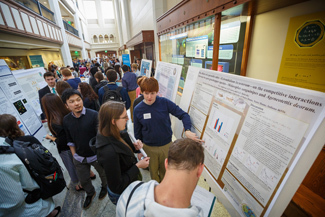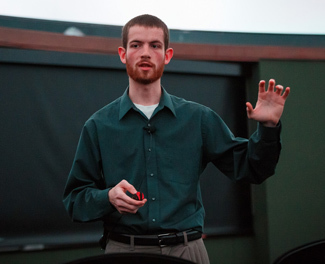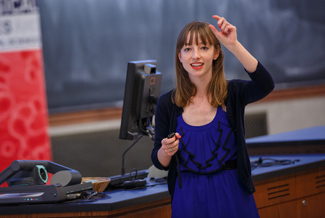On Friday, May 2, the eighth annual College of Science Joint Annual Meeting (COS-JAM) was held in the Jordan Hall of Science and featured over 140 research presentations from more than 180 student researchers. The mission of COS-JAM is to highlight undergraduate scientific research at the College of Science. COS-JAM is held in conjunction with the annual Undergraduate Scholars Conference at Notre Dame.

Poster presentations in the Galleria
Over 400 students and faculty attended COS-JAM to learn about research projects from all areas of science – biological sciences, chemistry and biochemistry, mathematics and physics. In addition to the Notre Dame undergraduates, five recipients of the Spirit of Science Awards from the Northern Indiana Regional Science and Engineering Fair presented their winning science projects during the poster session.
This year’s COS-JAM also featured new categories of research during the poster session from the Hillebrand Center for Compassionate Care in Medicine and Advanced Diagnostics & Therapeutics. In addition, one student created a presentation that was shown in the Digital Visualization Theater.
“COS-JAM showed again this year the diversity and quality of research being conducted by undergraduate students in the College of Science,” said Dominic Chaloner, undergraduate researcher coordinator for the College of Science and research associate professor of biological sciences. “The packed Galleria also demonstrated the keen interest amongst undergraduates in the research endeavors of their fellow students.”
The booklet of this year’s research abstracts is available on the College of Science website. A few of the presentations from each area are highlighted below.

Matthew Cole
Spirit of Science Award winner Anthony Kavanaugh implemented a project called, “The Effects of Road Salt on Daphnia magna.” Daphnia is a small planktonic crustacean found in aquatic environments throughout North America. Kavanaugh put several Daphnia into four different test environments: a road salt solution, plain salt solution, and spring water, and melted snow. He periodically monitored the number of Daphnia for 24 hours and found that populations were lowest in the plain salt and road salt solutions after 24 hours.
Physics
Senior physics major Matthew Cole’s gave his presentation “Visualizing Objects on the Galactic Scale” in the Digital Visualization Theater. The DVT is often used to illustrate the size of objects on a galactic scale. Using information from known asteroid orbits, his created a visual representation of a globular cluster, which is a group of over one million stars that are gravitationally bound together.
Mathematics
Sophomore Monica Gorman’s presentation discussed zero-knowledge proofs. Zero-knowledge proofs are able to show that a person has a certain piece of information, without revealing the specific piece of information. Zero-knowledge proofs have applications in cryptography and information theory.
Chemistry & Biochemistry

Rebecca Marton
Science preprofessional major Sean McGee presented an oral and poster presentation titled, “The incorporation of green design into iodine deficiency test: The Iron Nanoparticle ‘Kill Switch.’” A test for iodine deficiency has been developed using a paper analytical device (PAD), but the formulation of the PAD requires a small amount of arsenic, that originally exceed the EPA’s levels for safe disposal. McGee’s work focused on finding a way to transition the arsenic to a non-leachable form using iron oxide nanoparticles, so that the PADs could be safely discarded after use.
Biological Sciences
Rebecca Marton, a senior biological sciences major, gave a presentation called, “Molecular characterization of actin cytoskeletal proteins during retinal regeneration.” Using the zebrafish as a model, Marton’s research focused on determining whether actin/myosyin interactions were the driving force of interkinetic nuclear migration during retinal regeneration. These results are relevant for understanding neuronal processes and inherited human vision diseases, such as macular degeneration.
View a portion of Rebecca Marton's presentation.
Originally published by at science.nd.edu on May 09, 2014.